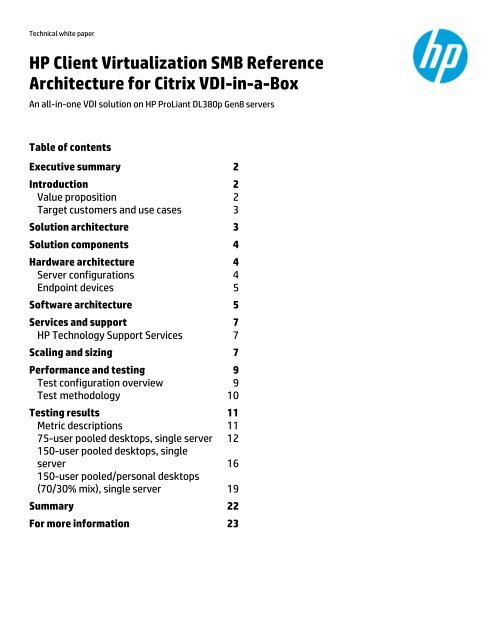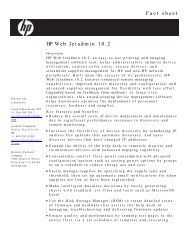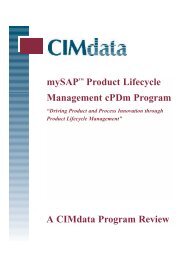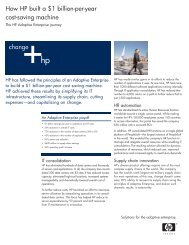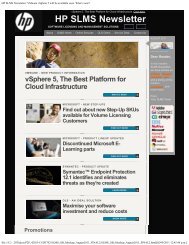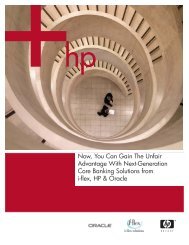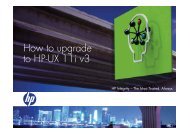HP Client Virtualization SMB Reference Architecture for Citrix VDI-in ...
HP Client Virtualization SMB Reference Architecture for Citrix VDI-in ...
HP Client Virtualization SMB Reference Architecture for Citrix VDI-in ...
Create successful ePaper yourself
Turn your PDF publications into a flip-book with our unique Google optimized e-Paper software.
Technical white paper<br />
<strong>HP</strong> <strong>Client</strong> <strong>Virtualization</strong> <strong>SMB</strong> <strong>Reference</strong><br />
<strong>Architecture</strong> <strong>for</strong> <strong>Citrix</strong> <strong>VDI</strong>-<strong>in</strong>-a-Box<br />
An all-<strong>in</strong>-one <strong>VDI</strong> solution on <strong>HP</strong> ProLiant DL380p Gen8 servers<br />
Table of contents<br />
Executive summary 2<br />
Introduction 2<br />
Value proposition 2<br />
Target customers and use cases 3<br />
Solution architecture 3<br />
Solution components 4<br />
Hardware architecture 4<br />
Server configurations 4<br />
Endpo<strong>in</strong>t devices 5<br />
Software architecture 5<br />
Services and support 7<br />
<strong>HP</strong> Technology Support Services 7<br />
Scal<strong>in</strong>g and siz<strong>in</strong>g 7<br />
Per<strong>for</strong>mance and test<strong>in</strong>g 9<br />
Test configuration overview 9<br />
Test methodology 10<br />
Test<strong>in</strong>g results 11<br />
Metric descriptions 11<br />
75-user pooled desktops, s<strong>in</strong>gle server 12<br />
150-user pooled desktops, s<strong>in</strong>gle<br />
server 16<br />
150-user pooled/personal desktops<br />
(70/30% mix), s<strong>in</strong>gle server 19<br />
Summary 22<br />
For more <strong>in</strong><strong>for</strong>mation 23
Executive summary<br />
This document describes a reference architecture—the <strong>HP</strong> <strong>Client</strong> <strong>Virtualization</strong> <strong>SMB</strong> <strong>Reference</strong> <strong>Architecture</strong> <strong>for</strong> <strong>Citrix</strong>®<br />
<strong>VDI</strong>-<strong>in</strong>-a-Box—that can be rapidly deployed to support a scalable Virtual Desktop Infrastructure (<strong>VDI</strong>) build<strong>in</strong>g block<br />
that is fully tested, pre-sized, benchmarked, and easy to implement. The reference architecture def<strong>in</strong>es 75- and 150user<br />
configurations based on the <strong>HP</strong> ProLiant DL380p Gen8 server and the <strong>Citrix</strong>® <strong>VDI</strong>-<strong>in</strong>-a-Box software. The<br />
configurations were extensively per<strong>for</strong>mance-tested to determ<strong>in</strong>e optimal siz<strong>in</strong>g, allow<strong>in</strong>g small and medium-sized<br />
customers to provision client desktop images to various worker types efficiently and quickly.<br />
This white paper is <strong>in</strong>tended <strong>for</strong> a technical audience of IT architects, adm<strong>in</strong>istrators, and managers, and describes<br />
test<strong>in</strong>g per<strong>for</strong>med <strong>in</strong> October 2012.<br />
Introduction<br />
<strong>Client</strong> virtualization used to be considered a large enterprise solution, but with improvements <strong>in</strong> virtualization software,<br />
br<strong>in</strong>g-your-own-device (BYOD)/mobility plans, and lower overall cost per user, client virtualization is quickly emerg<strong>in</strong>g <strong>in</strong><br />
the ma<strong>in</strong>stream small and medium-sized bus<strong>in</strong>ess (<strong>SMB</strong>) market. This technical document describes a reference<br />
architecture designed to help a channel reseller or customer construct a simple Virtual Desktop Infrastructure (<strong>VDI</strong>)<br />
configuration start<strong>in</strong>g at 75 users based on the <strong>HP</strong> ProLiant DL380p Gen8 server and <strong>Citrix</strong>® <strong>VDI</strong>-<strong>in</strong>-a-Box. The<br />
reference architecture—the <strong>HP</strong> <strong>Client</strong> <strong>Virtualization</strong> <strong>SMB</strong> <strong>Reference</strong> <strong>Architecture</strong> <strong>for</strong> <strong>Citrix</strong> <strong>VDI</strong>-<strong>in</strong>-a-Box (<strong>HP</strong> CV <strong>SMB</strong> RA<br />
<strong>for</strong> <strong>Citrix</strong>)—is an appliance-like configuration that removes the guesswork from siz<strong>in</strong>g and deploy<strong>in</strong>g a virtual desktop<br />
solution. By adher<strong>in</strong>g to the recommended guidel<strong>in</strong>es tested and validated by this reference architecture, you’ll know <strong>in</strong><br />
advance how many servers and what software licenses you’ll need to support various workloads. And because the<br />
solution follows a build<strong>in</strong>g block approach, it scales on demand without re-architecture or expensive <strong>in</strong>frastructure,<br />
deliver<strong>in</strong>g predictable, repeatable per<strong>for</strong>mance at a def<strong>in</strong>ed price po<strong>in</strong>t.<br />
Value proposition<br />
By provid<strong>in</strong>g a solution bluepr<strong>in</strong>t that has been fully tested, pre-sized, and optimized, the <strong>HP</strong> CV <strong>SMB</strong> RA <strong>for</strong> <strong>Citrix</strong> <strong>VDI</strong>-<strong>in</strong>a-Box<br />
accelerates time-to-production.<br />
The <strong>HP</strong> CV <strong>SMB</strong> RA <strong>for</strong> <strong>Citrix</strong> <strong>VDI</strong>-<strong>in</strong>-a-Box encompasses the follow<strong>in</strong>g components:<br />
<strong>Citrix</strong> <strong>VDI</strong>-<strong>in</strong>-a-Box software<br />
Microsoft® Hyper-V hypervisor<br />
<strong>HP</strong> ProLiant DL380p Gen8 Server<br />
<strong>HP</strong> Flexible Series Th<strong>in</strong> <strong>Client</strong>s or <strong>HP</strong> Smart Zero <strong>Client</strong>s<br />
The benefits of this solution <strong>in</strong>clude:<br />
Rapid deployment – In less than three hours you can import the <strong>VDI</strong>-<strong>in</strong>-a-Box software appliance to an <strong>HP</strong> ProLiant<br />
server, configure desktop images, and deliver virtual desktops to users. There is noth<strong>in</strong>g to architect or <strong>in</strong>stall, and no<br />
additional <strong>in</strong>frastructure, such as management servers, SQL databases, or storage area networks,<br />
is required.<br />
Predictable, repeatable cost, and per<strong>for</strong>mance – Whether you use a s<strong>in</strong>gle, standalone <strong>HP</strong> ProLiant DL380p Gen8<br />
server or a grid of multiple servers, the per<strong>for</strong>mance capacity per server rema<strong>in</strong>s unchanged—and that means<br />
predictable, af<strong>for</strong>dable cost and scalable per<strong>for</strong>mance.<br />
Built-<strong>in</strong> high availability – To protect users <strong>in</strong> the event of server failure without requir<strong>in</strong>g shared storage, you can<br />
add additional <strong>HP</strong> ProLiant DL380p Gen8 servers to the grid and the system automatically balances load across all<br />
servers, facilitat<strong>in</strong>g high availability.<br />
Rich high-def<strong>in</strong>ition end-user access to applications – Application access is delivered securely no matter what the<br />
access device. Us<strong>in</strong>g <strong>Citrix</strong> HDX and <strong>Citrix</strong> Receiver provided with <strong>Citrix</strong> <strong>VDI</strong>-<strong>in</strong>-a-Box, users can experience<br />
excellent per<strong>for</strong>mance over both WAN and LAN environments.<br />
Assured log-<strong>in</strong> per<strong>for</strong>mance – Users can access the <strong>in</strong><strong>for</strong>mation they need, when they need it, even when numerous<br />
users log <strong>in</strong> at the same time.<br />
Integrated solution-level per<strong>for</strong>mance – To reduce the demands on your IT staff, <strong>HP</strong> and <strong>Citrix</strong> eng<strong>in</strong>eers have<br />
validated all software and hardware components, so everyth<strong>in</strong>g works correctly, right out of the box.<br />
2
<strong>Citrix</strong> <strong>VDI</strong>-<strong>in</strong>-a-Box 5.1 enables s<strong>in</strong>gle <strong>in</strong>stance management to support personalized as well as pooled virtual desktops.<br />
Rather than juggl<strong>in</strong>g the demands of manag<strong>in</strong>g persistent desktops, IT can ma<strong>in</strong>ta<strong>in</strong> a s<strong>in</strong>gle master copy of desktop<br />
images while preserv<strong>in</strong>g the personalization of user applications and data. This dramatically reduces recurr<strong>in</strong>g<br />
management overhead and lowers datacenter storage costs.<br />
Target customers and use cases<br />
Typical <strong>VDI</strong>-<strong>in</strong>-a-Box customers need a simple, af<strong>for</strong>dable virtual desktop environment. <strong>VDI</strong> customers come from a<br />
range of various <strong>in</strong>dustries, <strong>in</strong>clud<strong>in</strong>g but not limited to:<br />
Education, such as universities, schools, and tra<strong>in</strong><strong>in</strong>g centers<br />
Public service, such as libraries, city halls, and police stations<br />
Healthcare, such as hospitals and medical group offices<br />
F<strong>in</strong>ancial services, such as credit unions and <strong>in</strong>surance companies<br />
Manufactur<strong>in</strong>g facilities<br />
In addition, regional or divisional offices of large organizations tend to look <strong>for</strong> simple and af<strong>for</strong>dable virtual desktop<br />
solutions where the <strong>HP</strong> CV <strong>SMB</strong> RA <strong>for</strong> <strong>Citrix</strong> <strong>VDI</strong>-<strong>in</strong>-a-Box may be a good fit. It is important to understand how<br />
employees at these customer organizations connect to their <strong>VDI</strong> desktops. There are two types of users to consider.<br />
First, there are on-premise desktop users connect<strong>in</strong>g to their desktops over wired and wireless connections. In addition,<br />
there are mobile executives, “road warriors”, or remote employees that access their desktops us<strong>in</strong>g mobile devices and<br />
wireless connections from off-premise locations, such as external client sites. <strong>HP</strong> CV <strong>SMB</strong> RA <strong>for</strong> <strong>Citrix</strong> <strong>VDI</strong>-<strong>in</strong>-a-Box with<br />
the HDX protocol provides excellent user experience over both LANs and WANs, enabl<strong>in</strong>g users to connect anytime, from<br />
anywhere, on any device and support<strong>in</strong>g both the on-premise desktop and mobile use cases.<br />
For customers look<strong>in</strong>g to deploy desktop virtualization across a large enterprise under multiple use cases and requir<strong>in</strong>g<br />
advanced management capabilities, please refer to the <strong>HP</strong> CV Gen8 RA <strong>for</strong> <strong>Citrix</strong> XenDesktop® on Microsoft Hyper-V<br />
and the technical documentation available at http://hp.com/go/cv.<br />
Solution architecture<br />
<strong>Citrix</strong> <strong>VDI</strong>-<strong>in</strong>-a-Box is a simple, all-<strong>in</strong>-one software that enables Microsoft® W<strong>in</strong>dows® adm<strong>in</strong>istrators to rapidly deliver<br />
centrally managed virtual desktops to any user, anytime, on any device—<strong>for</strong> less than the cost of<br />
traditional PCs.<br />
Figure 1 compares a traditional enterprise <strong>VDI</strong> production deployment with a <strong>VDI</strong>-<strong>in</strong>-a-Box solution. The traditional<br />
enterprise-class <strong>VDI</strong> deployment <strong>in</strong>cludes a pair of load balancers and connection brokers to manage connections to<br />
desktop sessions and ensure high-availability, as well as compute servers to run the desktops and management servers<br />
that provision and control the environment. SANs, high-speed <strong>in</strong>terconnects, and clustered SQL databases are also<br />
required. <strong>VDI</strong>-<strong>in</strong>-a-Box consolidates this functionality <strong>in</strong>to a software virtual appliance, elim<strong>in</strong>at<strong>in</strong>g much of the<br />
<strong>in</strong>frastructure <strong>in</strong> an enterprise implementation. With <strong>VDI</strong>-<strong>in</strong>-a-Box, the connection broker<strong>in</strong>g, load balanc<strong>in</strong>g, high<br />
availability, desktop provision<strong>in</strong>g, and management are all built <strong>in</strong> and managed through an <strong>in</strong>tuitive web-based<br />
console. This radically simplifies setup and management, lower<strong>in</strong>g both complexity and cost.<br />
Figure 1. How <strong>VDI</strong>-<strong>in</strong>-a-Box elim<strong>in</strong>ates complexity and lowers cost<br />
3
Solution components<br />
The components required to deploy this reference architecture are as follows:<br />
An <strong>HP</strong> ProLiant DL380p Gen8 Server<br />
A hypervisor. Although <strong>VDI</strong>-<strong>in</strong>-a-Box runs on multiple hypervisors, this reference architecture was tested with<br />
Microsoft Hyper-V. (For more <strong>in</strong><strong>for</strong>mation on <strong>Citrix</strong> <strong>VDI</strong>-<strong>in</strong>-a-Box supported hypervisors, please go to the <strong>Citrix</strong> <strong>VDI</strong><strong>in</strong>-a-Box<br />
website.)<br />
<strong>Citrix</strong> <strong>VDI</strong>-<strong>in</strong>-a-Box <strong>for</strong> Hyper-V, which runs as a virtual appliance on any Hyper-V-enabled server.<br />
Endpo<strong>in</strong>t devices. This reference architecture provides recommendations <strong>for</strong> <strong>HP</strong> Th<strong>in</strong> <strong>Client</strong>s.<br />
In addition, <strong>for</strong> secure remote access, <strong>Citrix</strong> NetScaler® can also be used.<br />
Hardware architecture<br />
Server configurations<br />
The <strong>HP</strong> ProLiant DL380p Gen8 server provides a full solution that is modular and scalable to meet a variety of customer<br />
needs. For the <strong>HP</strong> CV <strong>SMB</strong> RA <strong>for</strong> <strong>Citrix</strong> <strong>VDI</strong>-<strong>in</strong>-a-Box, the <strong>HP</strong> ProLiant DL380p Gen8 Server can be configured to support<br />
75 and 150 users runn<strong>in</strong>g a standard “Medium” user workload. “Medium” workload simulates the desktop activity of a<br />
typical knowledge worker us<strong>in</strong>g office applications and web browsers with media stream<strong>in</strong>g. Table 1 shows tested<br />
configurations <strong>for</strong> these user densities.<br />
Figure 2. <strong>HP</strong> ProLiant DL380p Gen8 (shown with optional 16 storage devices)<br />
4<br />
6G DP 10k<br />
SAS<br />
450 GB<br />
6G DP 10k<br />
SAS<br />
450 GB<br />
6G DP 10k<br />
SAS<br />
450 GB<br />
6G DP 10k<br />
SAS<br />
450 GB<br />
1<br />
2<br />
3<br />
4<br />
5<br />
6<br />
7<br />
8<br />
1 2 3 4<br />
PS1 NIC<br />
POWER OVER<br />
AMP<br />
PS2 CAP<br />
TEMP<br />
STATUS<br />
2 PROCS 1<br />
DIMMS<br />
2 4 6 8 10 12 2 4 6 8 10 12<br />
1 3 5 7 9 11 1 3 5 7 9 11<br />
FANS<br />
1 2 3 4 5 6<br />
Table 1. Tested Solutions <strong>for</strong> 75 and 150 Virtual Desktop Users<br />
6G DP 10k<br />
SAS<br />
450 GB<br />
6G DP 10k<br />
SAS<br />
450 GB<br />
6G DP 10k<br />
SAS<br />
450 GB<br />
6G DP 10k<br />
SAS<br />
450 GB<br />
Server Specs <strong>for</strong> 75 Users Qty. <strong>HP</strong> PN Server Specs <strong>for</strong> 150 Users Qty. <strong>HP</strong> PN<br />
<strong>HP</strong> ProLiant DL380p Gen8 Server<br />
(with <strong>HP</strong> Smart Array P420i)<br />
(1) Intel® Xeon® E5-2680 @ 2.70GHz<br />
CPU<br />
UID<br />
ProLiant<br />
DL380p<br />
Gen8<br />
1 653200-B21 <strong>HP</strong> ProLiant DL380p Gen8 Server<br />
(with <strong>HP</strong> Smart Array P420i)<br />
1 662228-L21 (2) Intel® Xeon® E5-2680 @ 2.70GHz CPU 1<br />
1<br />
1 653200-B21<br />
662228-L21<br />
662228-B21<br />
128GB RAM (16GB x 8) 8 647901-B21 256GB RAM (16GB x 16) 16 647901-B21<br />
8 Drives*<br />
(6) 300GB 6G SAS 10,000 RPM<br />
drives, RAID 0+1<br />
(2) 200GB 6G SAS SLC SSDs, RAID 1<br />
<strong>HP</strong> Smart Array P420i/2GB with Flash<br />
Backed Write Cache (FBWC) (RAID 0+1)<br />
6<br />
2<br />
652564-B21<br />
653078-B21<br />
8 Drives*<br />
(6) 300GB 6G SAS 10,000 RPM<br />
drives, RAID 0+1<br />
(2) 200GB 6G SAS SLC SSDs, RAID 1<br />
1 631681-B21 <strong>HP</strong> Smart Array P420i/2GB with Flash<br />
Backed Write Cache (FBWC) (RAID 0+1)<br />
6<br />
2<br />
652564-B21<br />
653078-B21<br />
1 631681-B21<br />
<strong>HP</strong> 10GbE 2P 530FLR Ethernet Adapter 1 684210-B21 <strong>HP</strong> 10GbE 2P 530FLR Ethernet Adapter 1 684210-B21<br />
750W Power Supply Kit 1 656363-B21 750W Power Supply Kit 2 656363-B21<br />
*Can be expanded to 16 drives maximum
This reference architecture uses solid-state drives (SSDs) as well as traditional hard disk drives (HDDs) with the <strong>HP</strong><br />
ProLiant DL380p Gen8 server. Although SSDs tend to be more expensive than traditional hard disk drives, they do not<br />
exhibit latencies imposed by mov<strong>in</strong>g parts and can there<strong>for</strong>e deliver thousands of IOPS, <strong>in</strong> contrast to hundreds of IOPS<br />
<strong>for</strong> HDDs. In this solution, SSDs store the “golden” desktop image and help to significantly <strong>in</strong>crease desktop<br />
per<strong>for</strong>mance, enabl<strong>in</strong>g higher user densities.<br />
It is possible to scale storage capacity beyond the tested configurations described <strong>in</strong> this reference architecture. For<br />
example, 450GB 10k SAS drives can optionally be used <strong>in</strong> place of the 300GB ones. An optional storage cage can further<br />
<strong>in</strong>crease drive density from 8 to 16 drives—<strong>in</strong> this case, a second RAID controller must also be added.<br />
Endpo<strong>in</strong>t devices<br />
<strong>VDI</strong>-<strong>in</strong>-a-Box uses <strong>Citrix</strong> Receiver along with <strong>Citrix</strong> HDX protocol to provide virtual desktops to almost any device <strong>for</strong>m<br />
factor: th<strong>in</strong> clients, desktop PCs, laptops, tablets, and smartphones. Through <strong>Citrix</strong> Receiver, <strong>VDI</strong>-<strong>in</strong>-a-Box provides fast,<br />
reliable virtual desktops to over 2 billion <strong>Citrix</strong> Receiver-enabled devices sold.<br />
<strong>HP</strong> CV <strong>SMB</strong> RA <strong>for</strong> <strong>Citrix</strong> <strong>VDI</strong>-<strong>in</strong>-a-Box works with <strong>HP</strong> Flexible Series Th<strong>in</strong> <strong>Client</strong>s. The <strong>HP</strong> t610 or <strong>HP</strong> t510 Flexible Series<br />
W<strong>in</strong>dows Embedded Standard 7 (WES7) Th<strong>in</strong> <strong>Client</strong>s benefit from full HDX capabilities while potentially improv<strong>in</strong>g server<br />
scalability s<strong>in</strong>ce they can per<strong>for</strong>m <strong>Citrix</strong> client-side render<strong>in</strong>g. These th<strong>in</strong> clients are ideal <strong>for</strong> customers requir<strong>in</strong>g an<br />
advanced graphical user experience. Customers select<strong>in</strong>g the <strong>HP</strong> t610 over the <strong>HP</strong> t510 will benefit from a more<br />
powerful CPU, graphics hardware acceleration, quad-display, <strong>in</strong>ternal dual-antenna Wi-Fi, Fiber NIC, and PCIe expansion<br />
bay options. Customers who purchase the <strong>HP</strong> t610 typically have a greater mix of remotely virtualized apps and locally<br />
embedded apps. Both the <strong>HP</strong> t610 family and the <strong>HP</strong> t510 th<strong>in</strong> clients come standard with dual-core CPUs and legacy<br />
ports <strong>for</strong> powerful, flexible connectivity to a broad array of peripheral devices. Smart Zero Technology can also be<br />
deployed on the Flexible Series Th<strong>in</strong> <strong>Client</strong>s, provid<strong>in</strong>g a “zero touch” experience at the endpo<strong>in</strong>t device. For additional<br />
details, go to <strong>HP</strong> Flexible Series Th<strong>in</strong> <strong>Client</strong>s.<br />
Figure 3. <strong>HP</strong> Flexible Series Th<strong>in</strong> <strong>Client</strong>s<br />
Software architecture<br />
The software components <strong>in</strong> a <strong>Citrix</strong> <strong>VDI</strong>-<strong>in</strong>-a-Box deployment <strong>in</strong>clude:<br />
<strong>Citrix</strong> <strong>VDI</strong>-<strong>in</strong>-a-Box<br />
<strong>Citrix</strong> Receiver<br />
Microsoft Hyper-V hypervisor<br />
Optionally, software to support the use of Smart Zero<br />
<strong>Citrix</strong> <strong>VDI</strong>-<strong>in</strong>-a-Box<br />
<strong>VDI</strong>-<strong>in</strong>-a-Box is designed to make virtual desktop adm<strong>in</strong>istration easy, automated, and cost-effective <strong>for</strong> desktop IT<br />
while deliver<strong>in</strong>g a rich user experience. Key features <strong>in</strong>clude:<br />
Efficient support <strong>for</strong> both pooled and personalized virtual desktops. Pooled desktops are standardized virtual<br />
desktops that run from a s<strong>in</strong>gle, centralized virtual desktop “golden” image. Pooled desktops are a good solution <strong>for</strong><br />
students or task workers s<strong>in</strong>ce they offer a high-level of adm<strong>in</strong>istrative control, en<strong>for</strong>ce security, and reduce<br />
management costs by prevent<strong>in</strong>g users from mak<strong>in</strong>g permanent changes to their environment. In addition to pooled<br />
desktops, <strong>VDI</strong>-<strong>in</strong>-a-Box 5.1 provides efficient support <strong>for</strong> personalized desktops <strong>in</strong> which users can customize a<br />
5
6<br />
“golden” image, <strong>in</strong>stall<strong>in</strong>g their own applications and stor<strong>in</strong>g their own configuration <strong>in</strong><strong>for</strong>mation and data on a<br />
personal virtual disk (vDisk). Personalized desktops provide the best of both worlds: users get personalized desktops<br />
while IT can manage a s<strong>in</strong>gle master image, much like pooled desktops, sav<strong>in</strong>g time and money while deliver<strong>in</strong>g a<br />
highly personalized end-user experience. <strong>VDI</strong>-<strong>in</strong>-a-Box 5.1 delivers both pooled and personalized virtual desktops<br />
us<strong>in</strong>g a centrally managed golden image approach.<br />
Simple and <strong>in</strong>tuitive adm<strong>in</strong>istration. Po<strong>in</strong>t-and-click wizards guide you through key virtual desktop adm<strong>in</strong>istration<br />
tasks, such as desktop image preparation and updates. <strong>VDI</strong>-<strong>in</strong>-a-Box 5.1 has an expanded set of wizards to cover<br />
frequent operations, and sett<strong>in</strong>g up and upgrad<strong>in</strong>g master images is simple. The <strong>VDI</strong>-<strong>in</strong>-a-Box grid appears as one<br />
logical server, thus elim<strong>in</strong>at<strong>in</strong>g the need to manage servers <strong>in</strong>dividually.<br />
Support <strong>for</strong> more than two billion devices. With <strong>Citrix</strong> Receiver, you can provide secure access to any desktop from<br />
any of over two billion devices, <strong>in</strong>clud<strong>in</strong>g iOS, Android, WebOS, Chrome OS, Mac OS, L<strong>in</strong>ux and W<strong>in</strong>dows PCs, th<strong>in</strong><br />
clients, and mobile devices.<br />
Built-<strong>in</strong> scalability and high-availability. Traditional <strong>VDI</strong> solutions require shared storage to deliver high availability.<br />
In production sett<strong>in</strong>gs, this means a SAN with high-speed <strong>in</strong>terconnects. While this type of shared storage<br />
environment is suitable <strong>for</strong> enterprise class deployment, the solution can quickly get complex and expensive, and<br />
requires specialized adm<strong>in</strong>istrative expertise. <strong>VDI</strong>-<strong>in</strong>-a-Box elim<strong>in</strong>ates this requirement, provid<strong>in</strong>g high availability<br />
and scal<strong>in</strong>g via <strong>in</strong>expensive direct-attached storage (DAS). By runn<strong>in</strong>g <strong>VDI</strong>-<strong>in</strong>-a-Box <strong>in</strong> an N+1 configuration (i.e., on<br />
two or more servers), the <strong>VDI</strong>-<strong>in</strong>-a-Box grid automatically load balances and takes advantage of redundancy <strong>for</strong> high<br />
availability. In the event of a server failure, <strong>VDI</strong>-<strong>in</strong>-a-Box automatically rebalances the desktop load across the<br />
rema<strong>in</strong><strong>in</strong>g healthy servers to prevent outages. <strong>VDI</strong>-<strong>in</strong>-a-Box 5.1 extends built-<strong>in</strong> high availability to device access and<br />
Microsoft Active Directory. When an IT environment is configured <strong>for</strong> Active Directory failover, <strong>VDI</strong>-<strong>in</strong>-a-Box 5.1 will<br />
default to a backup Active Directory server when a primary server fails. <strong>VDI</strong>-<strong>in</strong>-a-Box 5.1 features a grid-wide virtual<br />
IP address, mak<strong>in</strong>g the entire grid accessible through a s<strong>in</strong>gle highly available virtual IP address. These capabilities<br />
promote end-to-end high availability regardless of the endpo<strong>in</strong>t device be<strong>in</strong>g used and without the need <strong>for</strong> a load<br />
balancer.<br />
<strong>Citrix</strong> Receiver<br />
Users today typically use multiple comput<strong>in</strong>g devices—<strong>in</strong>clud<strong>in</strong>g smartphones, tablets and PCs—and crave a consistent<br />
comput<strong>in</strong>g experience across all of them. Organizations everywhere are struggl<strong>in</strong>g to cope with the rapid proliferation of<br />
devices and yet give users the mobile, high-def<strong>in</strong>ition experience they demand.<br />
<strong>Citrix</strong> Receiver is a free, easy-to-<strong>in</strong>stall software client that lets you access enterprise data, applications and desktops<br />
from any of these comput<strong>in</strong>g devices. In tandem with a <strong>Citrix</strong>-enabled IT <strong>in</strong>frastructure, <strong>Citrix</strong> Receiver provides<br />
consistent, secure, high-per<strong>for</strong>mance access without <strong>in</strong>troduc<strong>in</strong>g layers of IT management complexity. It is a key<br />
enabl<strong>in</strong>g technology <strong>for</strong> organizations that want to adopt a br<strong>in</strong>g-your-own-device (BYOD) strategy that promotes the<br />
ad hoc use of personal devices to supplement or replace corporate endpo<strong>in</strong>ts.<br />
<strong>Citrix</strong> Receiver is a client-based plug-<strong>in</strong> that is <strong>in</strong>stalled on the user’s endpo<strong>in</strong>t device. It works <strong>in</strong> conjunction with <strong>Citrix</strong><br />
<strong>VDI</strong>-<strong>in</strong>-a-Box when the user requires the ability to <strong>in</strong>teract with their virtual desktop. When a user logs <strong>in</strong>to a <strong>VDI</strong>-<strong>in</strong>-a-<br />
Box site to access a virtual desktop, the website can detect whether <strong>Citrix</strong> Receiver is absent from the endpo<strong>in</strong>t,<br />
automatically prompt<strong>in</strong>g the user if necessary to download and <strong>in</strong>stall it.<br />
Smart Zero technology<br />
Available on <strong>HP</strong> Smart Zero (<strong>HP</strong> t410) and Flexible Th<strong>in</strong> <strong>Client</strong>s (<strong>HP</strong> t510 and <strong>HP</strong> t610), <strong>HP</strong> Smart Zero Technology gives<br />
you a simple, reprogrammable, and af<strong>for</strong>dable solution. It supports multiple protocols and can be reprogrammed on the<br />
fly, deliver<strong>in</strong>g a no-compromise, <strong>in</strong>telligent zero client experience <strong>for</strong> remote and cloud comput<strong>in</strong>g environments. With<br />
<strong>HP</strong> Smart Zero Technology <strong>in</strong>stalled on the virtualization <strong>in</strong>frastructure, it allows end users to be up and runn<strong>in</strong>g <strong>in</strong><br />
seconds with no configuration or management required on the device side. Just set up the server, boot the client, and<br />
connect. <strong>HP</strong> Smart Zero Technology comb<strong>in</strong>es the benefits of a zero client with <strong>HP</strong> auto-sens<strong>in</strong>g technology that<br />
automatically connects to the network and searches <strong>for</strong> the right client virtualization <strong>in</strong>frastructure and downloads<br />
everyth<strong>in</strong>g it needs to deliver a robust user experience. The user is up and runn<strong>in</strong>g quickly with no local user <strong>in</strong>terface<br />
and just three steps from log on to productivity.<br />
For more details, see Server-Side Smart Zero Technology Component.
Services and support<br />
Complete your <strong>HP</strong> <strong>Client</strong> <strong>Virtualization</strong> <strong>SMB</strong> <strong>Reference</strong> <strong>Architecture</strong> <strong>for</strong> <strong>Citrix</strong> <strong>VDI</strong>-<strong>in</strong>-a-Box solution with services and<br />
support, delivered by <strong>HP</strong> experts you trust.<br />
<strong>HP</strong> Technology Support Services<br />
The new <strong>HP</strong> Technology Support portfolio features three levels of on-go<strong>in</strong>g customer support services and a<br />
comprehensive family of added value service offer<strong>in</strong>gs that customers can deploy as needed.<br />
The portfolio <strong>in</strong>cludes:<br />
<strong>HP</strong> Foundation Care – A portfolio of reactive hardware and software support services that is now significantly<br />
enhanced with the <strong>in</strong>troduction of <strong>HP</strong> Collaborative Support.<br />
<strong>HP</strong> Proactive Care – An <strong>in</strong>novative, higher value support services leverag<strong>in</strong>g new product technology and <strong>HP</strong> support<br />
<strong>in</strong>frastructure <strong>in</strong>vestments to achieve an unprecedented price po<strong>in</strong>t <strong>for</strong> proactive support.<br />
<strong>HP</strong> Datacenter Care – Our most flexible level of support, which is personalized, tailored to the needs of each<br />
customer. This environmental support covers heterogeneous hardware and software <strong>in</strong> the datacenter, and enables<br />
our customers to br<strong>in</strong>g expertise from all of <strong>HP</strong> to bear on their needs.<br />
<strong>HP</strong> Lifecycle Event Services – A complete portfolio of ad hoc services that reduce customer’s time to value<br />
throughout the technology lifecycle.<br />
<strong>HP</strong> recommends <strong>HP</strong> Proactive Care <strong>for</strong> the <strong>HP</strong> <strong>VDI</strong>-<strong>in</strong>-a-Box <strong>SMB</strong> RA. Customers with a more environmental approach<br />
should consider <strong>HP</strong> Datacenter Care.<br />
Scal<strong>in</strong>g and siz<strong>in</strong>g<br />
This reference architecture provides siz<strong>in</strong>g options <strong>for</strong> servers tested with 75 and 150 users runn<strong>in</strong>g standard ‘‘Medium”<br />
virtual desktop workloads as def<strong>in</strong>ed by Log<strong>in</strong>VSI. The <strong>HP</strong> ProLiant DL380p Gen8 server was configured with the<br />
necessary CPU cores, RAM, and disk sp<strong>in</strong>dles to support a given number of W<strong>in</strong>dows 7 desktops.<br />
Scal<strong>in</strong>g and high-availability<br />
<strong>VDI</strong>-<strong>in</strong>-a-Box provides on-demand scal<strong>in</strong>g and provides built-<strong>in</strong> high-availability us<strong>in</strong>g an N+1 model. Additional servers<br />
can be added as more desktop capacity is required, and the <strong>VDI</strong>-<strong>in</strong>-a-Box software automatically configures and<br />
provisions the server to run virtual desktops. <strong>VDI</strong>-<strong>in</strong>-a-Box architecture delivers built-<strong>in</strong> high availability without shared<br />
storage or connection brokers—all that is needed is one additional server <strong>in</strong> the grid. With an N+1 configuration, <strong>VDI</strong>-<strong>in</strong>a-Box<br />
automatically ensures that if one server fails, another server is able to host the virtual desktops. Due to the<br />
shared-noth<strong>in</strong>g architecture, all servers are equally replaceable. When a physical server fails, the rema<strong>in</strong><strong>in</strong>g servers <strong>in</strong><br />
the grid have the needed <strong>in</strong><strong>for</strong>mation, <strong>in</strong>clud<strong>in</strong>g templates and images, to create extra desktops to replace those on the<br />
failed server. When the failed server is repaired and rejo<strong>in</strong>s the grid, key operational and configuration <strong>in</strong><strong>for</strong>mation is<br />
<strong>for</strong>warded to it, allow<strong>in</strong>g it to then resume desktop provision<strong>in</strong>g.<br />
The figure below illustrates three server configurations. The top configuration consists of a s<strong>in</strong>gle server designed to<br />
host 150 virtual desktops. The middle configuration shows two servers jo<strong>in</strong>ed together <strong>in</strong> a grid and sized to either run<br />
150 virtual desktops <strong>in</strong> high-availability (HA) mode or 300 desktops without HA. In the HA configuration, when one<br />
server fails, the rema<strong>in</strong><strong>in</strong>g server runs all 150 desktops until the failed server is repaired and restored <strong>in</strong>to the grid. In<br />
non-HA mode, 300 desktops can be run across the two servers. If a server fails <strong>in</strong> a non-HA configuration, only 150<br />
desktops of the 300 are available <strong>for</strong> use until the failed server is repaired and returned to the grid. The third<br />
configuration supports 300 users with HA or 450 users without HA. Likewise, more servers can be added to the grid to<br />
<strong>in</strong>crease the capacity of the solution. This illustrates the simplicity of <strong>VDI</strong>-<strong>in</strong>-a-Box and the advantages of its all-<strong>in</strong>-one<br />
appliance approach. Everyth<strong>in</strong>g that’s needed—all the management software and all the hardware, <strong>in</strong>clud<strong>in</strong>g local<br />
storage—is provided <strong>in</strong> a s<strong>in</strong>gle appliance, allow<strong>in</strong>g a seamless, “no th<strong>in</strong>k” approach to production scal<strong>in</strong>g that features<br />
high availability.<br />
7
Figure 4. Server configurations<br />
150 Users<br />
8<br />
6G DP 10k<br />
SAS<br />
450 GB<br />
6G DP 10k<br />
SAS<br />
450 GB<br />
6G DP 10k<br />
SAS<br />
450 GB<br />
6G DP 10k<br />
SAS<br />
450 GB<br />
1<br />
2<br />
3<br />
4<br />
6G DP 10k<br />
SAS<br />
450 GB<br />
6G DP 10k<br />
SAS<br />
450 GB<br />
6G DP 10k<br />
SAS<br />
450 GB<br />
6G DP 10k<br />
SAS<br />
450 GB<br />
5<br />
6<br />
7<br />
8<br />
1 2 3 4<br />
PS1 NIC<br />
POWER OVER<br />
AMP<br />
PS2 CAP<br />
TEMP<br />
STATUS<br />
2 PROCS 1<br />
DIMMS<br />
2 4 6 8 10 12 2 4 6 8 10 12<br />
1 3 5 7 9 11 1 3 5 7 9 11<br />
FANS<br />
1 2 3 4 5 6<br />
150 Users with HA or 300 Users without HA<br />
6G DP 10k<br />
SAS<br />
450 GB<br />
6G DP 10k<br />
SAS<br />
450 GB<br />
6G DP 10k<br />
SAS<br />
450 GB<br />
6G DP 10k<br />
SAS<br />
450 GB<br />
6G DP 10k<br />
SAS<br />
450 GB<br />
6G DP 10k<br />
SAS<br />
450 GB<br />
6G DP 10k<br />
SAS<br />
450 GB<br />
6G DP 10k<br />
SAS<br />
450 GB<br />
1<br />
2<br />
3<br />
4<br />
1<br />
2<br />
3<br />
4<br />
6G DP 10k<br />
SAS<br />
450 GB<br />
6G DP 10k<br />
SAS<br />
450 GB<br />
6G DP 10k<br />
SAS<br />
450 GB<br />
6G DP 10k<br />
SAS<br />
450 GB<br />
6G DP 10k<br />
SAS<br />
450 GB<br />
6G DP 10k<br />
SAS<br />
450 GB<br />
6G DP 10k<br />
SAS<br />
450 GB<br />
6G DP 10k<br />
SAS<br />
450 GB<br />
5<br />
6<br />
7<br />
8<br />
5<br />
6<br />
7<br />
8<br />
1 2 3 4<br />
PS1 NIC<br />
POWER OVER<br />
AMP<br />
PS2 CAP<br />
TEMP<br />
STATUS<br />
2 PROCS 1<br />
DIMMS<br />
2 4 6 8 10 12 2 4 6 8 10 12<br />
1 3 5 7 9 11 1 3 5 7 9 11<br />
FANS<br />
1 2 3 4 5 6<br />
1 2 3 4<br />
PS1 NIC<br />
POWER OVER<br />
AMP<br />
PS2 CAP<br />
TEMP<br />
STATUS<br />
2 PROCS 1<br />
DIMMS<br />
2 4 6 8 10 12 2 4 6 8 10 12<br />
1 3 5 7 9 11 1 3 5 7 9 11<br />
FANS<br />
1 2 3 4 5 6<br />
300 Users with HA or 450 Users without HA<br />
6G DP 10k<br />
SAS<br />
450 GB<br />
6G DP 10k<br />
SAS<br />
450 GB<br />
6G DP 10k<br />
SAS<br />
450 GB<br />
6G DP 10k<br />
SAS<br />
450 GB<br />
6G DP 10k<br />
SAS<br />
450 GB<br />
6G DP 10k<br />
SAS<br />
450 GB<br />
6G DP 10k<br />
SAS<br />
450 GB<br />
6G DP 10k<br />
SAS<br />
450 GB<br />
6G DP 10k<br />
SAS<br />
450 GB<br />
6G DP 10k<br />
SAS<br />
450 GB<br />
6G DP 10k<br />
SAS<br />
450 GB<br />
6G DP 10k<br />
SAS<br />
450 GB<br />
1<br />
2<br />
3<br />
4<br />
1<br />
2<br />
3<br />
4<br />
1<br />
2<br />
3<br />
4<br />
6G DP 10k<br />
SAS<br />
450 GB<br />
6G DP 10k<br />
SAS<br />
450 GB<br />
6G DP 10k<br />
SAS<br />
450 GB<br />
6G DP 10k<br />
SAS<br />
450 GB<br />
6G DP 10k<br />
SAS<br />
450 GB<br />
6G DP 10k<br />
SAS<br />
450 GB<br />
6G DP 10k<br />
SAS<br />
450 GB<br />
6G DP 10k<br />
SAS<br />
450 GB<br />
6G DP 10k<br />
SAS<br />
450 GB<br />
6G DP 10k<br />
SAS<br />
450 GB<br />
6G DP 10k<br />
SAS<br />
450 GB<br />
6G DP 10k<br />
SAS<br />
450 GB<br />
5<br />
6<br />
7<br />
8<br />
5<br />
6<br />
7<br />
8<br />
5<br />
6<br />
7<br />
8<br />
1 2 3 4<br />
PS1 NIC<br />
POWER OVER<br />
AMP<br />
PS2 CAP<br />
TEMP<br />
STATUS<br />
2 PROCS 1<br />
DIMMS<br />
2 4 6 8 10 12 2 4 6 8 10 12<br />
1 3 5 7 9 11 1 3 5 7 9 11<br />
FANS<br />
1 2 3 4 5 6<br />
1 2 3 4<br />
PS1 NIC<br />
POWER OVER<br />
AMP<br />
PS2 CAP<br />
TEMP<br />
STATUS<br />
2 PROCS 1<br />
DIMMS<br />
2 4 6 8 10 12 2 4 6 8 10 12<br />
1 3 5 7 9 11 1 3 5 7 9 11<br />
FANS<br />
1 2 3 4 5 6<br />
1 2 3 4<br />
PS1 NIC<br />
POWER OVER<br />
AMP<br />
PS2 CAP<br />
TEMP<br />
STATUS<br />
2 PROCS 1<br />
DIMMS<br />
2 4 6 8 10 12 2 4 6 8 10 12<br />
1 3 5 7 9 11 1 3 5 7 9 11<br />
FANS<br />
1 2 3 4 5 6<br />
UID<br />
ProLiant<br />
DL380p<br />
Gen8<br />
UID<br />
ProLiant<br />
DL380p<br />
Gen8<br />
UID<br />
ProLiant<br />
DL380p<br />
Gen8<br />
UID<br />
ProLiant<br />
DL380p<br />
Gen8<br />
UID<br />
ProLiant<br />
DL380p<br />
Gen8<br />
UID<br />
ProLiant<br />
DL380p<br />
Gen8<br />
Calculat<strong>in</strong>g storage requirements<br />
While the CPU cores, server memory and IOPS figures have been pre-calculated with<strong>in</strong> this reference architecture, each<br />
<strong>in</strong>dividual use case must determ<strong>in</strong>e how much storage capacity is required <strong>in</strong> a particular environment.<br />
The number of pooled versus personal desktops is a significant factor <strong>in</strong> calculat<strong>in</strong>g the amount of storage needed,<br />
along with the number of shared golden images. Pooled desktops use only about 15% of the size of a golden image per<br />
desktop. This sav<strong>in</strong>gs is due to the implementation of pooled desktops through “l<strong>in</strong>ked clones” <strong>in</strong> which desktops share<br />
a common master image, reduc<strong>in</strong>g storage capacity requirements. With l<strong>in</strong>ked clones, when desktops are provisioned, a<br />
separate, small difference disk is created. All changes to the desktop—such as registry changes or <strong>in</strong>stallation of new<br />
applications—are stored <strong>in</strong> its difference disk. All reads use the parent disk or the golden image itself. The difference<br />
disk grows with use over time. For non-persistent desktops that are refreshed periodically, these difference disks are<br />
typically very small, usually about 10-15% of the golden image. This reference architecture assumes that pooled<br />
desktops are refreshed frequently (at least weekly or bi-weekly), and that user and profile data is stored externally. If<br />
that is not the case, or if applications require additional write space, you should allocate more than 15% of the “golden”<br />
image size per pooled desktop, or consider the provision<strong>in</strong>g of personalized desktops.<br />
Calculat<strong>in</strong>g the required storage capacity follows several basic <strong>for</strong>mulas. To estimate the storage needed, you’ll first<br />
need to know the number of golden images, the size of each golden image, the number of pooled desktops, the number<br />
of personal desktops, and the size of the personal vDisk to be provisioned <strong>for</strong> each personal desktop. The paragraphs<br />
below describe the general <strong>for</strong>mulas used to estimate the amount of storage needed. (<strong>Citrix</strong> makes available an on-l<strong>in</strong>e<br />
<strong>VDI</strong>-<strong>in</strong>-a-Box 5.1 Server Siz<strong>in</strong>g Calculator that follows these <strong>for</strong>mulas to predict the amount of storage required <strong>in</strong> a<br />
deployment.)<br />
The first <strong>for</strong>mula estimates the amount of storage needed <strong>for</strong> golden images:<br />
Formula 1: 2 X (Size of Golden image) X (Number of Golden Images) = Disk space (GB) required <strong>for</strong> Golden Images<br />
For example, if there are two 20GB golden images, the <strong>for</strong>mula is as follows:<br />
Example 1: 2 x 20GB x 2 Golden Images = 80GB<br />
The second <strong>for</strong>mula determ<strong>in</strong>es how much space the pooled desktops consume. The rule of thumb is that each l<strong>in</strong>ked<br />
clone takes up roughly 15% of the golden image size. Assum<strong>in</strong>g a 20GB golden image, the l<strong>in</strong>ked clone storage<br />
calculation <strong>for</strong> 105 pooled desktops is as follows:<br />
Formula 2: 15% X (Size of Golden image) X (Number of Pooled Desktops) = Disk space (GB) <strong>for</strong> Pooled Desktops<br />
Example 2: 15% of 20GB x 105 Pooled Desktops = 315GB
The next <strong>for</strong>mula determ<strong>in</strong>es how much space is required <strong>for</strong> personalized desktops. Personal desktops are assigned<br />
us<strong>in</strong>g a vDisk template that varies <strong>in</strong> size from 4GB to 60GB (the default is 8GB). Us<strong>in</strong>g the 8GB default, the storage<br />
calculation <strong>for</strong> 45 personal desktops would be as follows:<br />
Formula 3: (Size of VHD Template) X (Number of Personal Desktops) = Disk space (GB) <strong>for</strong> Personal Desktops<br />
Example 3: 8GB x 45 Personal Desktops = 360GB<br />
The last <strong>for</strong>mula determ<strong>in</strong>es the amount of swap space to configure. This value represents the memory allocated <strong>for</strong><br />
each virtual desktop times the total number of virtual desktops configured:<br />
Formula 4: (VM RAM Size) X (Number of VMs) = Disk space (GB) <strong>for</strong> swap<br />
Example 4: (2GB x 150 Pooled or Personal Desktops) = 300GB<br />
Options <strong>for</strong> expand<strong>in</strong>g storage<br />
Storage is easily expanded beyond the capacity of the tested configurations <strong>in</strong> this reference architecture. Larger<br />
capacities can accommodate larger personal vDisks that are used <strong>in</strong> conjunction with personalized desktops. The tested<br />
Pooled with Personal Desktop configuration over-commits storage, so there is the possibility of a storage shortfall if<br />
several users’ personal vDisks expand to their maximum capacity (10GB per desktop). Of course, this is dependent on<br />
the number of applications that each user <strong>in</strong>stalls. For this reason, each site must determ<strong>in</strong>e storage capacity based on<br />
<strong>in</strong>dividual workload requirements.<br />
There are several options <strong>for</strong> expand<strong>in</strong>g storage capacity <strong>in</strong> this reference architecture. First, 450GB 10k SAS drives can<br />
optionally replace the 300GB drives <strong>in</strong> the tested configurations. Also, add<strong>in</strong>g a second RAID controller and an optional<br />
storage cage can <strong>in</strong>crease the number of drives from 8 to 16.<br />
Per<strong>for</strong>mance and test<strong>in</strong>g<br />
The follow<strong>in</strong>g section describes per<strong>for</strong>mance test<strong>in</strong>g and presents key results <strong>for</strong> the <strong>HP</strong> CV <strong>SMB</strong> RA <strong>for</strong> <strong>Citrix</strong> <strong>VDI</strong>-<strong>in</strong>-a-<br />
Box solution. In this test<strong>in</strong>g, a s<strong>in</strong>gle server configuration was customized to accommodate 75 and 150<br />
user deployments.<br />
Test configuration overview<br />
Tests were per<strong>for</strong>med us<strong>in</strong>g Log<strong>in</strong> VSI (www.log<strong>in</strong>vsi.com), a load generation tool <strong>for</strong> <strong>VDI</strong> benchmark<strong>in</strong>g that simulates<br />
production user workloads to generate desktop workloads and gather data about <strong>VDI</strong> per<strong>for</strong>mance. All tests were done<br />
us<strong>in</strong>g the default Medium workload to simulate the desktop activity of a typical knowledge worker. Log<strong>in</strong> VSI generates<br />
an office productivity workload that <strong>in</strong>cludes Office 2010 with Microsoft Outlook, Word, PowerPo<strong>in</strong>t, and Excel, Internet<br />
Explorer with a Flash video applet, Java app, and Adobe® Acrobat® Reader.<br />
Pooled versus personal desktops<br />
The test results presented <strong>in</strong> this reference architecture compare workloads of pooled versus personalized desktop<br />
users. Pooled desktops allow multiple virtual desktops to run from a s<strong>in</strong>gle, centralized virtual desktop image. By us<strong>in</strong>g<br />
a centralized virtual desktop image, adm<strong>in</strong>istrators have the option to simply <strong>in</strong>stall all required bus<strong>in</strong>ess applications<br />
directly on that golden image, which is then referenced <strong>in</strong> <strong>Citrix</strong> <strong>VDI</strong>-<strong>in</strong>-a-Box as Pooled Desktops with Installed<br />
Applications. The pooled desktop and <strong>in</strong>stalled application model can be implemented quickly and with a m<strong>in</strong>imal<br />
amount of <strong>in</strong>frastructure us<strong>in</strong>g l<strong>in</strong>ked clones.<br />
Personalized desktops are created from a published W<strong>in</strong>dows 7 image through the <strong>VDI</strong>-<strong>in</strong>-a-Box adm<strong>in</strong>istrative<br />
<strong>in</strong>terface. They leverage the simplicity of pooled desktop management while enabl<strong>in</strong>g the customization of a personal<br />
vDisk. Adm<strong>in</strong>istrators can customize and ma<strong>in</strong>ta<strong>in</strong> the golden image with applications, just as <strong>in</strong> pooled desktops. In<br />
addition, users can <strong>in</strong>stall their own applications <strong>in</strong> their personal vDisk. When the published golden image is updated,<br />
the base image of all personal desktops is automatically updated with the adm<strong>in</strong>istrator’s changes while the user<strong>in</strong>stalled<br />
applications, profiles, and data on the personal vDisk rema<strong>in</strong> <strong>in</strong>tact. <strong>Citrix</strong> recommends us<strong>in</strong>g a profile<br />
management application with the personal desktop feature—<strong>Citrix</strong> Profile management is <strong>in</strong>cluded with <strong>VDI</strong>-<strong>in</strong>-a-Box.<br />
9
Test environment and components<br />
The test environment <strong>in</strong>cluded these core components:<br />
<strong>Citrix</strong> <strong>VDI</strong>-<strong>in</strong>-a-Box. <strong>Citrix</strong> <strong>VDI</strong>-<strong>in</strong>-a-Box is a complete <strong>VDI</strong> solution designed to scale simply by add<strong>in</strong>g additional units,<br />
and features built-<strong>in</strong> connection broker<strong>in</strong>g and load balanc<strong>in</strong>g across multiple servers. It takes advantage of the <strong>Citrix</strong><br />
Receiver and the HDX protocol to support a variety of device types, <strong>in</strong>clud<strong>in</strong>g smartphones, tablets, th<strong>in</strong> clients,<br />
laptops, and workstations. The test<strong>in</strong>g used the default HDX sett<strong>in</strong>gs with a resolution of 1024x768 and Flash<br />
redirection was disabled.<br />
Microsoft W<strong>in</strong>dows Server 2008 R2 SP1 Hyper-V. <strong>VDI</strong>-<strong>in</strong>-a-Box runs on Microsoft Hyper-V, <strong>Citrix</strong> XenServer®, and<br />
VMware vSphere hypervisors. The test<strong>in</strong>g <strong>for</strong> this solution used Microsoft Hyper-V. Hyper-V Dynamic Memory was<br />
used <strong>for</strong> all test<strong>in</strong>g with these parameters: 1GB startup RAM, 3GB maximum RAM, and 20% buffer.<br />
Desktop VM. The desktop VM image deployed a 32-bit <strong>in</strong>stance of Microsoft W<strong>in</strong>dows 7 SP1 us<strong>in</strong>g 1 virtual CPU and<br />
1-3GB of dynamic memory. Note: The Log<strong>in</strong> VSI Medium workload consumes approx. 800MB of RAM per desktop VM.<br />
<strong>HP</strong> ProLiant DL380p Gen8 Server. The test<strong>in</strong>g used an <strong>HP</strong> ProLiant DL380p Gen8 <strong>in</strong> two different configurations to<br />
support capacities of 75 and 150 users. To support 75 users, the server was configured with a s<strong>in</strong>gle Intel Xeon E5-<br />
2680 CPU @ 2.70GHz (8 cores, 16 threads) and 128GB of memory, while the 150-user configuration had twice the CPU<br />
and memory resources — two Intel Xeon E5-2680 CPUs and 256GB of memory. The local storage configuration was<br />
the same <strong>for</strong> both configurations; only the compute and memory resources differed. The server used an <strong>HP</strong> Smart<br />
Array 6 Gb/s PCIe 3.0 SAS controller and was configured with two datastores as follows:<br />
10<br />
Pooled Desktops Solution:<br />
– Datastore1 C: Drive - (2) SSDs, configured as RAID1, 186GB Total<br />
Hyper-V OS<br />
(1) golden image<br />
Note: 27GB storage consumed.<br />
– Datastore2 D: Drive - (6) 10k RPM SAS drives, configured as RAID0+1, 838GB Total<br />
(150) l<strong>in</strong>ked clone VHDs (pooled desktops VMs)<br />
Hyper-V VM configuration files (i.e., *.b<strong>in</strong> files that are the same size as the allocated RAM per VM)<br />
OS pagefile (20GB)<br />
Note: 424GB storage consumed.<br />
Personal Desktops Solution:<br />
– Datastore1 C: Drive - (2) SSDs, RAID1, 186GB Total<br />
Hyper-V OS<br />
(2) golden images<br />
Note: 56GB storage consumed.<br />
– Datastore2 D: Drive - (6) 10k RPM SAS drives, RAID0+1, 838GB Total<br />
(105) pooled desktop VMs (l<strong>in</strong>ked clone VHDs)<br />
(45) personal desktops – <strong>in</strong>cludes both sets of VHDs (i.e., same l<strong>in</strong>ked clone VHDs as pooled desktops,<br />
plus personal vDisk VHDs)<br />
Hyper-V VM configuration files (i.e., *.b<strong>in</strong> files that are the same size as the allocated RAM per VM)<br />
OS pagefile (20GB)<br />
Note: 291GB storage consumed.<br />
Pooled desktops were tested along with a mix of 70% pooled and 30% personal desktops. To simulate a real-world<br />
scenario, Microsoft Office 2010, M<strong>in</strong>dMap, and Adobe Acrobat Reader were <strong>in</strong>stalled <strong>in</strong> the personal vDisk, while Flash,<br />
Shockwave, Java, and the Bullzip pr<strong>in</strong>t driver were <strong>in</strong>stalled <strong>in</strong> the base image (s<strong>in</strong>ce these are considered foundation<br />
applications).<br />
Test methodology<br />
Each test run followed this sequence of steps:<br />
1) Us<strong>in</strong>g the <strong>VDI</strong>-<strong>in</strong>-a-Box Management Console, all desktops were powered up and <strong>in</strong> an idle “Hold” state.<br />
2) The VSI launchers were restarted and verified as ready <strong>for</strong> test<strong>in</strong>g.
3) A PerfMon script was started to capture comprehensive system per<strong>for</strong>mance metrics.<br />
4) With the desktops powered up and idle, Log<strong>in</strong> VSI began the workload simulation portion of the test. Depend<strong>in</strong>g on<br />
the test run, either 75 or 150 desktop sessions were launched at 30-second sequential <strong>in</strong>tervals and Log<strong>in</strong> VSI <strong>in</strong>itiated<br />
user log<strong>in</strong>s to start the test run.<br />
Once all users were logged <strong>in</strong>, the steady state portion of the test began <strong>in</strong> which Log<strong>in</strong> VSI cont<strong>in</strong>ued to track<br />
application per<strong>for</strong>mance statistics, loop<strong>in</strong>g through specific operations and measur<strong>in</strong>g response times at regular<br />
<strong>in</strong>tervals. Response times are used to determ<strong>in</strong>e Log<strong>in</strong> VSImax, the maximum number of users that the test<br />
environment can support be<strong>for</strong>e per<strong>for</strong>mance degrades consistently. In the test<strong>in</strong>g, Log<strong>in</strong> VSI def<strong>in</strong>es success criteria as<br />
application response times lower than the VSImax threshold (over the basel<strong>in</strong>e) with exceptions occurr<strong>in</strong>g less than six<br />
times consecutively. This is calculated by averag<strong>in</strong>g the response time of the first 15 Log<strong>in</strong> VSI measurements. The<br />
<strong>for</strong>mula <strong>for</strong> the dynamic VSImax threshold is: Avg. Basel<strong>in</strong>e Response Time x 125% + 3000. As a result, when the<br />
basel<strong>in</strong>e response time is 1800, the VSImax threshold is 1800 x 125% + 3000 = 5250ms.<br />
For the test runs of 75 and 150 users, VSImax scores were not reached.<br />
5) After a specified amount of elapsed steady state time (300 seconds), Log<strong>in</strong> VSI started to log off the desktop<br />
sessions.<br />
6) After all sessions were logged off, the per<strong>for</strong>mance monitor<strong>in</strong>g scripts were stopped. S<strong>in</strong>ce the desktops were<br />
configured with roam<strong>in</strong>g profiles, the locally cached profiles were deleted at logoff.<br />
7) Lastly, the Log<strong>in</strong> VSI logs were processed us<strong>in</strong>g VSI Analyzer and PerfMon CSV us<strong>in</strong>g PAL (Per<strong>for</strong>mance Analysis of<br />
Logs) to analyze the test results presented here.<br />
Test<strong>in</strong>g results<br />
This section provides data po<strong>in</strong>ts that a customer may reference <strong>in</strong> design<strong>in</strong>g their own implementations.<br />
Metric descriptions<br />
VSImax Scores: Derived from the Log<strong>in</strong> VSI Analysis Tool, this data determ<strong>in</strong>es the VSImax, which is the maximum<br />
capacity of the tested system expressed as the number of Log<strong>in</strong> VSI sessions. With<strong>in</strong> each workload test loop the<br />
response times of seven specific operations are measured at a regular <strong>in</strong>terval: six times with<strong>in</strong> each loop. The response<br />
times of these seven operations are used to establish VSImax.<br />
Hyper-V Physical Server Processor Analysis: This analysis checks the processor utilization of physical processors <strong>in</strong> the<br />
host computer. The "\Hyper-V Hypervisor Logical Processor(*)\% Total Run Time" per<strong>for</strong>mance counter is more accurate<br />
than us<strong>in</strong>g the "% Processor Time" counter on the host, root partition computer because the "% Processor Time" counter<br />
only measures the processor time of the host, root partition computer only. The "\Hyper-V Hypervisor Logical<br />
Processor(*)\% Total Run Time" per<strong>for</strong>mance counter is the best counter to use to analyze overall processor utilization<br />
of the Hyper-V server.<br />
Note: Because the other server components (RAM, storage, etc.) were sized and configured proportionally, CPU<br />
utilization was the gat<strong>in</strong>g factor <strong>for</strong> determ<strong>in</strong><strong>in</strong>g the desktop host server capacity.<br />
Hyper-V Hypervisor Logical Processor Context Switches/sec: The rate of virtual processor context switches on the<br />
processor. This is the number of times a new Virtual Processor (VP) has been scheduled to a particular Logical Processor<br />
(LP).<br />
Memory Available Mbytes: Available MBytes is the amount of physical RAM, <strong>in</strong> Megabytes, immediately available <strong>for</strong><br />
allocation to a process or <strong>for</strong> system use. It is equal to the sum of memory assigned to the standby (cached), free and<br />
zero page lists. If this counter is low, then the computer is runn<strong>in</strong>g low on physical RAM.<br />
PhysicalDisk Calculated IOPS: Disk Reads and Writes/sec is the rate of read and write operations on the disk.<br />
PhysicalDisk Avg. Disk Queue Length: Avg. Disk Queue Length is the average number of both read and write requests<br />
that were queued <strong>for</strong> the selected disk dur<strong>in</strong>g the sample <strong>in</strong>terval.<br />
Network Interface Bytes Total/sec: Bytes Total/sec is the rate at which bytes are sent and received over each network<br />
adapter, <strong>in</strong>clud<strong>in</strong>g fram<strong>in</strong>g characters. Network Interface\Bytes Total/sec is a sum of Network Interface\Bytes<br />
Received/sec and Network Interface\Bytes Sent/sec.<br />
11
75-user pooled desktops, s<strong>in</strong>gle server<br />
This section conta<strong>in</strong>s Log<strong>in</strong> VSI test results <strong>for</strong> the server configured to run 75 W<strong>in</strong>dows 7 pooled desktops. The Log<strong>in</strong><br />
VSI tests <strong>in</strong>dicate that VSImax was not reached. (In separate test<strong>in</strong>g, Log<strong>in</strong> VSImax was reached at 80 users.) This means<br />
that good user experience was achieved with this configuration when runn<strong>in</strong>g 75 users.<br />
Figure 5. Log<strong>in</strong> VSI Data (no VSI Max reached)<br />
12
Figure 6. CPU (S<strong>in</strong>gle, 16 logical cores)<br />
Figure 7. Memory (128GB Total)<br />
13
Figure 8. Storage IOPS & Queue Length<br />
14
Figure 9. Network<br />
15
150-user pooled desktops, s<strong>in</strong>gle server<br />
The follow<strong>in</strong>g are Log<strong>in</strong> VSI test results <strong>for</strong> the server configured to run 150 W<strong>in</strong>dows 7 pooled desktops. The Log<strong>in</strong> VSI<br />
tests <strong>in</strong>dicate that “VSI MAX” was not reached. (In separate test<strong>in</strong>g, Log<strong>in</strong> VSImax was reached at 163 users.) This means<br />
that good user experience was achieved with this configuration with 150 users.<br />
Figure 10. Log<strong>in</strong> VSI Data (no VSI Max reached)<br />
16
Figure 11. CPU (Dual, 32 logical cores)<br />
Figure 12. Memory (256GB Total<br />
)<br />
17
Figure 13. Storage IOPS & Queue Length<br />
18
Figure 14. Network<br />
150-user pooled/personal desktops (70/30% mix), s<strong>in</strong>gle server<br />
The follow<strong>in</strong>g are Log<strong>in</strong> VSI test results <strong>for</strong> the server configured to run a mix of pooled and personalized W<strong>in</strong>dows 7<br />
desktops. The mix consisted of 70% pooled desktops and 30% personal desktops, with 150 desktops total. The Log<strong>in</strong><br />
VSI tests <strong>in</strong>dicate that VSImax was not reached. This means that good user experience was achieved with this<br />
configuration when runn<strong>in</strong>g 150 users.<br />
19
Figure 15. Log<strong>in</strong> VSI Data (no VSI Max reached<br />
Figure 16. CPU (Dual, 32 logical cores)<br />
20
Figure 17. Memory (256GB Total)<br />
Figure 18. Storage IOPS & Queue Length<br />
21
Figure 19. Network<br />
Summary<br />
The configurations described <strong>in</strong> this reference architecture have been validated through this test<strong>in</strong>g to be a good fit <strong>for</strong><br />
75 and 150 users under a medium workload. Together, the <strong>Citrix</strong> <strong>VDI</strong>-<strong>in</strong>-a-Box and <strong>HP</strong> ProLiant DL380p Gen8 server<br />
technologies <strong>in</strong> this reference architecture deliver predictable per<strong>for</strong>mance <strong>in</strong> a scalable build<strong>in</strong>g block. Along with the<br />
flexibility of personalized desktops, the solution offers many benefits of traditional enterprise <strong>VDI</strong> without the<br />
associated complexity and startup cost, provid<strong>in</strong>g a very practical, cost-effective, and easy-to-ma<strong>in</strong>ta<strong>in</strong> <strong>VDI</strong> solution <strong>for</strong><br />
small and medium-sized bus<strong>in</strong>esses.<br />
22
For more <strong>in</strong><strong>for</strong>mation<br />
<strong>HP</strong> technical documentation, hp.com/go/cv<br />
<strong>HP</strong> ProLiant DL380p Gen8 servers, hp.com/servers/dl380<br />
<strong>HP</strong> Flexible Series Th<strong>in</strong> <strong>Client</strong>s, hp.com/sbso/busproducts-th<strong>in</strong>-clients.html<br />
<strong>HP</strong> CV Gen8 Enterprise RA <strong>for</strong> <strong>Citrix</strong> XenDesktop on Microsoft Hyper-V – Overview,<br />
http://h10010.www1.hp.com/wwpc/us/en/sm/WF05a/457757-457757-5163273-5094724-5163275-<br />
5275757.html?dnr=1<br />
General product <strong>in</strong>fo, citrix.com/products/vdi-<strong>in</strong>-a-box/overview.html<br />
Feature descriptions, citrix.com/products/vdi-<strong>in</strong>-a-box/features.html<br />
<strong>Citrix</strong> technical documentation, http://support.citrix.com/proddocs/topic/vdi-51/vdi-about.html<br />
<strong>VDI</strong>-<strong>in</strong>-a-Box 5.1 Server Siz<strong>in</strong>g, http://support.citrix.com/proddocs/topic/vdi-51/vdi-siz<strong>in</strong>g.html<br />
<strong>VDI</strong>-<strong>in</strong>-a-Box 5.1 Server Siz<strong>in</strong>g Calculator,<br />
citrix.com/content/dam/citrix/en_us/documents/products/citrixvdi_<strong>in</strong>_a_box5.1serversiz<strong>in</strong>gcalculator.xlt<br />
To help us improve our documents, please provide feedback at hp.com/solutions/feedback.<br />
Get connected<br />
hp.com/go/getconnected<br />
Current <strong>HP</strong> driver, support, and security alerts<br />
delivered directly to your desktop<br />
© Copyright 2012 Hewlett-Packard Development Company, L.P. The <strong>in</strong><strong>for</strong>mation conta<strong>in</strong>ed here<strong>in</strong> is subject to change without notice. The only<br />
warranties <strong>for</strong> <strong>HP</strong> products and services are set <strong>for</strong>th <strong>in</strong> the express warranty statements accompany<strong>in</strong>g such products and services. Noth<strong>in</strong>g here<strong>in</strong><br />
should be construed as constitut<strong>in</strong>g an additional warranty. <strong>HP</strong> shall not be liable <strong>for</strong> technical or editorial errors or omiss ions conta<strong>in</strong>ed here<strong>in</strong>.<br />
<strong>Citrix</strong> (NASDAQ:CTXS) is the company trans<strong>for</strong>m<strong>in</strong>g how people, bus<strong>in</strong>esses and IT work and collaborate <strong>in</strong> the cloud era. With market-lead<strong>in</strong>g<br />
cloud, collaboration, network<strong>in</strong>g and virtualization technologies, <strong>Citrix</strong> powers mobile workstyles and cloud serv ices, mak<strong>in</strong>g complex enterprise IT<br />
simpler and more accessible <strong>for</strong> 260,000 enterprises. <strong>Citrix</strong> touches 75 percent of Internet users each day and partners with more than 10,000<br />
companies <strong>in</strong> 100 countries. Annual revenue <strong>in</strong> 2011 was $2.21 billion. Learn more at www.citrix.com.<br />
<strong>Citrix</strong>® <strong>VDI</strong>-<strong>in</strong>-a-Box, <strong>Citrix</strong> Receiver, HDX, XenDesktop®, XenServer® and NetScaler® are trademarks or registered trademarks of <strong>Citrix</strong><br />
Systems, Inc. and/or one or more of its subsidiaries, and may be registered <strong>in</strong> the United States Patent and Trademark Office and <strong>in</strong> other countries.<br />
All other trademarks and registered trademarks are property of their respective owners.<br />
Microsoft and W<strong>in</strong>dows are U.S. registered trademarks of Microsoft Corporation. Intel and Xeon are trademarks of Intel Corporation <strong>in</strong> the U.S. and<br />
other countries. Oracle is a registered trademark of Oracle and/or its affiliates. Adobe and Acrobat are trademarks of Adobe Systems Incorporated.<br />
4AA4-2774ENW, Created July 2012; Updated November 2012, Rev. 1<br />
23


